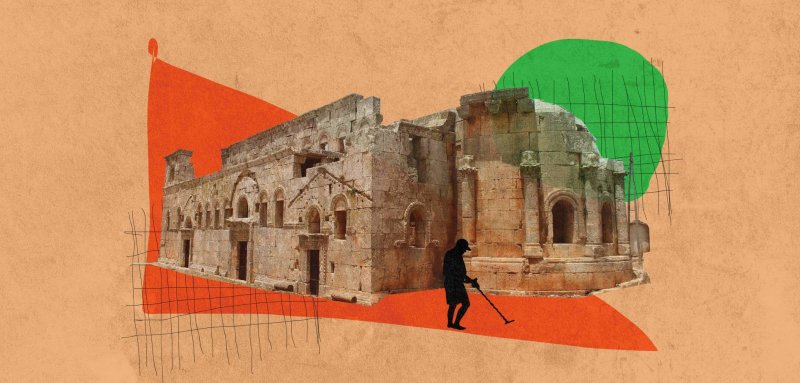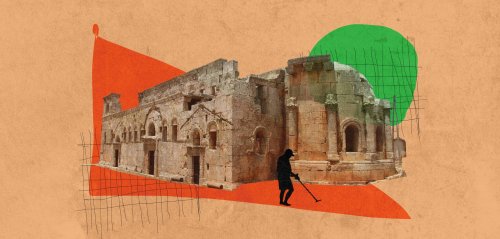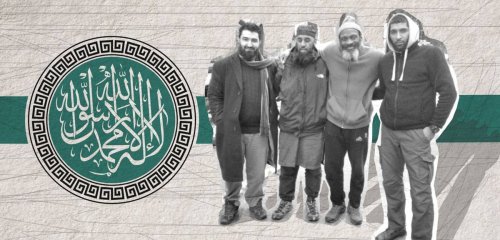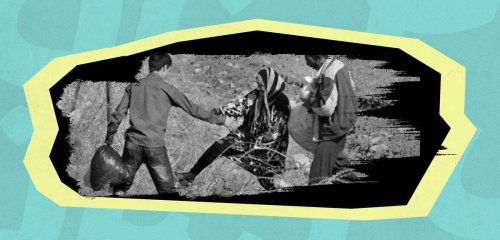Hassan (pseudonym) never anticipated the way his life changed seven years ago when he stumbled upon a buried treasure, a stash of gold, during a two-month-long excavation project with his brother on the outskirts of Hosh Al-Salihiyya town in the countryside of Damascus.
Speaking to Raseef22, Hassan says, "My brother informed me about an old mud-brick house in Hosh Al-Salihiyya that supposedly held a treasure. However, due to its proximity to a military base belonging to the opposition, the owners of the abandoned house were too afraid to retrieve it. We decided to rent a land property close to the house and conducted our secret dig every three or four days to avoid arousing suspicion. Finally, on one fateful night, we successfully extracted a buried treasure consisting of 23 pieces of gold."
Driven by his passion for the ancient profession of excavation, Hassan relocated to northern Syria, where he settled in the Afrin district of Aleppo in 2018. From there, he set on a lifelong quest for uncovering archaeological and gold treasures. Yet, the search is no longer as straightforward as it had been when he first arrived in the area. Describing the challenges, Hassan states, "The Aleppo countryside, including border towns like Jarabulus, as well as specific areas in the suburbs of Afrin, Ain Dara, al-Nabi Huri, Barad, Bassouta, Jindires, and the surrounding vicinity of al-Ma'batli, is rich in treasures and artifacts. However, searching and excavating now require utmost secrecy, due to the control of different factions over these areas and their division of the region into sectors among themselves. As a result, exploring the vicinity exposes you to a significant risk that may cost you your life."
Today, focus has shifted to searching for mediocre jewelry, metal coins, and medium-priced copper pieces
Moreover, Hassan remarks that "the field of treasure hunting and excavation is one of the domains where forgery, fraud, and theft are most prevalent. Anyone who wishes to work in the field of excavation in a specific area must exercise caution and either work under the utmost secrecy or negotiate a certain percentage levy with the faction that controls the area where the treasures are located. Typically, three-quarters of the findings go to the faction, while one-quarter goes to the excavator."
He adds, "In any case, you are forced to accept these terms, as your livelihood requires you to work to provide for your family. With the scarcity of job opportunities, the potential of a valuable find may help you escape poverty.”
Cheap prices and an open market for all
It can be observed that since the outbreak of the Syrian revolution, there has been a growing interest in various types of archaeological excavations, as well as gold treasures and the flourishing trade associated with them. This is highlighted by the heavy involvement of all conflict parties – without exception – in excavation and search operations that are being conducted overtly with neither supervision nor accountability. Among these operations, some are carried out randomly and in amateur fashion, while others are methodological and conducted under the supervision of experienced individuals capable of deciphering codes, ciphers, and special signals in archaeological sites and treasures.
Nevertheless, with the worsening living conditions in Syria, the phenomenon of looting and treasure hunting has spread to every Syrian province. This is particularly evident in the archaeological sites of Palmyra in central Homs, as well as in Idlib and Aleppo in northwestern Syria. These areas are home to significant archaeological sites, such as the "Ancient Villages of Northern Syria" that were added to UNESCO's World Heritage List in 2011. These sites encompass over 800 ancient villages and cities within the administrative borders of Aleppo and Idlib provinces, covering an area of approximately 5,600 square kilometers. The rectangular area is bordered by the al-Nabi Huri site to the north, Apamea to the south, the Khan Shaykhun road to the east, and the Al Asi valley, al-Ghab plain, and Afrin valley to the west.
For many years, Abu Ali, a resident of Idlib who requested that Raseef22 not disclose his full name, has been involved in treasure hunting and the trade of artifacts in various locations across Syria. For him, it is more of a hobby than a profession. His work has been involved with archaeological hills, ancient sites, mud-brick houses, and ancient tombs. In one of these sites, he discovered a collection of 15 Byzantine coins that he sold for $4,000 to a person engaged in the antiquities trade and with extensive connections to a high-ranking member of Tahrir al-Sham, according to what Abu Ali tells Raseef22.
Abu Ali admits that the price point at which he sold the coins “represents a quarter of their true value. There is no legitimate market for such artifacts," he adds, "except through trafficking them to specific individuals in Idlib who set the prices." He asserts that this is done despite knowledge that the true value of ancient coins is determined by their historical significance, inscriptions, and overall condition. Abu Ali remarks, “the challenge lies not only in finding the archaeological treasures but also in selling them discreetly, because as soon as they are offered for sale, attention is drawn to the seller.”
In his search for treasures, Abu Ali utilizes a mine detection device, as well as the essential tools for primitive excavation, in archaeologically-rich areas and sites near ancient Roman tombs. The search process usually begins at night using the detection device, which signals the presence of metals at a depth of approximately 50 centimeters. Subsequently, the excavation and exploration process commences. However, weeks can pass without any significant findings, asserts Abu Ali.
Work restrictions
Due to increased scrutiny by Tahrir al-Sham, Abu Ali has shifted his focus to searching for jewelry, metal coins, and midrange copper artifacts that can be detected by his device. Rare finds, such as gold, glassware, statues, mosaic panels, clay and pottery tablets, as well as engravings and numerals from ancient civilizations, require extensive efforts, prolonged research, and expertise in deciphering codes and symbols. Despite the challenges posed by Tahrir al-Sham’s tightening control over treasure hunting activities, Abu Ali believes that the potential rewards make the endeavor worthwhile.
The Aleppo countryside is rich in treasures and artifacts, but search and excavation require utmost secrecy due to the control of different factions over the areas, dividing the region into sectors, so any exploring runs a risk that may cost you your life
He says, "The [Tahrir al-Sham] organization, along with the other factions that it expelled from Idlib, thoroughly explored every archaeological site, unearthing numerous historical treasures and Roman and Byzantine artifacts. They also facilitated smuggling them through intermediaries to Turkey, where there exists a wider blackmarket with thousands of artifacts up for sale."
He further highlights that "gold artifacts are sold locally to gold traders after being melted down, mostly in 24-carat purity. On the other hand, metallic and stone antiquities, as well as glass artifacts, are smuggled into Turkey. Their true value is rarely paid due to the abundance of middlemen, and buyers are emboldened by their knowledge of the difficulty in selling such items. If you refuse to sell,” says Abu Ali, “the client might report you to the organization's security office, which results in you losing the artifact altogether and puts you at risk of arrest and prosecution."
It appears that the chances of unearthing valuable treasures are diminishing day by day, as Abu Ali asserts. This is due to the strict measures imposed by the Tahrir al-Sham organization, their monopoly over excavation, trade, and smuggling operations, as well as the presence of exclusively organized networks consisting of traders, brokers, and intermediaries connected to the organization's security office. These networks have intricate relationships with areas controlled by the regime, the Syrian Democratic Forces (SDF), and Turkey. They are the driving force behind trade operations, especially those directed towards Turkey from regime-held areas and the Aleppo countryside under the control of the National Army, or areas in Idlib governed by Tahrir al-Sham.
Indiscriminate excavations and documented violations
In late October, the group called "Syrians for Truth and Justice" (STJ), a documentation organization focusing on violations in Syria, published a report detailing excavation and digging operations for artifacts in the ancient "Ezra Synagogue" located in the town of Tadef in the Aleppan countryside. The report states that these excavation activities, having commenced in late 2012, continued until mid-last year and encompassed the entire town. Noteworthy, Tadef is jointly controlled by the regime's Fourth Division and the Hamza Division affiliated with the National Army.
According to the STJ’s report, satellite imagery revealed extensive digging in Tadef, and sources corroborated the extraction of ancient coins for the purpose of trading. Moreover, these sources confirmed coordination between the two parties controlling the town in order to excavate three additional sites, as well as an extra site in the neighboring village of Kreiz.
The Aleppo province is renowned as a treasure trove of antiquities. The town of Tadef, in proximity to the city, is home to several archaeological mosques, in addition to the Ezra Synagogue, which is approximately 2,350 years old and ranks as the second oldest worldwide. Idlib, likewise, boasts over a thousand archaeological sites, comprising almost one-third of Syria's historical artifacts dating from various epochs ranging from prehistoric eras to the late Islamic period. In addition, Idlib houses 40 archaeological villages, five of which are registered as World Heritage Sites, along with several castles, 200 archaeological mounds, and various architectural heritage within urban centers ranging from baths to mosques from different Islamic periods. These details were provided by Ayman Nabo, the director of the Archaeological Center in Idlib that is affiliated with the Salvation Government, the civilian branch of Tahrir al-Sham, and a de facto alternative government of the Syrian opposition.
Satellite imagery revealed extensive digging in Tadef, while sources confirmed the extraction of ancient coins for the purpose of trading
Nabo tells Raseef22, "Excavation operations are both old and ongoing as long as black markets exist. They are fueled by artifact poachers, looters, and treasure hunters in war-torn regions where administrative control and the rule of law have weakened. This is particularly true amidst deteriorating living conditions, widespread unemployment, and the lack of security." He affirms that 65% of archaeological sites have been indiscriminately pillaged by artifact looters, especially in archaeological hills, based on illusions, speculations, and misleading historical information claiming that these hills contain precious treasures and artifacts.
Chasing illusions
Nabo explains that "an archaeological site is a place where a complete social life existed during a specific period. It includes rooms, baths, and storage rooms. Excavators select a section of the site, such as a room, and randomly begin digging operations, driven by the speculation of a hidden treasure or valuable artifacts." He points out that "this doesn't mean that they won't find some metal objects, coins, pottery, lamps, and glassware, but they are not of the exorbitant value that is often assumed. Anything uncovered is purely a matter of chance."
He further adds, "Foreign archaeological missions, driven by scientific and professional motives, focus on studying specific historical periods in the region and examining the tools crafted by human civilizations. They are not motivated by the search for treasures and valuables, as some might believe."
The Aleppo province is renowned as a treasure trove of antiquities, including a 2,350 year-old synagogue that ranks as the 2nd oldest worldwide. Idlib boasts over a thousand archaeological sites ranging from prehistoric eras to the late Islamic period
Excavators typically employ mine detection devices that emit sounds when encountering metals at a certain underground depth. Some, albeit a minority, use specialized excavation devices smuggled into Syrian territories through Turkey. However, despite high costs reaching $8,000 per device, excavators maintain that their effectiveness is limited. Primitive digging tools like shovels and pickaxes are also commonly used, leading to the loss of significant archaeological features, especially when digging next to the foundations. This can result in wall collapses, the mutilation of archaeological artifacts, and the loss of ancient architectural elements and intricate features. Additionally, there is an inherent risk to the excavators' safety, particularly in archaeological hills that experience soil shifts. Moreover, excavators may encounter wells and tunnels prone to collapse that pose an additional threat to their lives.
Hegemony over the smuggling trade
The trade of antiquities stands as one of the primary sources of revenue for Tahrir al-Sham. Covert excavation activities persist in various sites, including the Qalb Loze archaeological area among others. Previously, the Salvation Government issued a directive cautioning against engaging in excavation and archaeological searches in any historical landmark unless explicitly authorized by the Directorate of Culture and approved by the Prime Minister's Council, under the risk of legal consequences.
In a report released in March by the European University Institute (EUI), it was noted that the smuggling of artifacts from Syria to Turkey remains active along the border regions of Idlib and Aleppo. Estimating the extent of the illicit trade is impossible; however, smuggling activities in areas under the control of Tahrir al-Sham are considerably more pronounced compared to those in areas controlled by the National Army. This can be attributed to various factors – the most prominent of which being the substantial presence of the Turkish military in those areas. Notwithstanding, Tahrir al-Sham exercises complete control over the excavation and smuggling of artifacts, both of which constitute a significant income for the organization. Proceeds from sales are doled out among the experts, smugglers, intermediaries, the armed groups that secure the sites, and on-site workers (with excavation fees not exceeding $50 per person).
“Gold artifacts are sold locally to gold traders after being melted down, whereas metallic and stone antiquities, as well as glass artifacts, are smuggled into Turkey. Their true price is rarely paid due to the large number of intermediaries and middlemen”
Omar al-Buniya, a journalist specialized in archaeology, affirms that factions in northern Syria, including Tahrir al-Sham, are involved in random and illicit excavation operations. The exception granted by the Tahrir al-Sham government for excavation purposes is merely an attempt to legitimize the excavation of artifacts under the guise of scientific research.
In a conversation with Raseef22, al-Buniya explains, "Their involvement in excavation, looting of artifacts, and their trade is not a recent phenomenon. It dates back to late 2013 when they entered the Maaloula archaeological site in northeastern Damascus. They collaborated with regime forces and members of Hezbollah in looting operations and the transportation of artifacts to Lebanon." He also notes that Tahrir al-Sham capitalizes on services and resources from every possible sector, such as dealing in antiquities, smuggling fuel, crossing-border services, real estate, and others.
"We all remember how the UN Security Council, in 2015, imposed a ban on all forms of trade in Syrian artifacts after reports revealed that ISIS and Jabhat al-Nusra (currently Tahrir al-Sham) were generating significant revenue from illicit artifact trade," concludes al-Buniya.
Raseef22 is a not for profit entity. Our focus is on quality journalism. Every contribution to the NasRaseef membership goes directly towards journalism production. We stand independent, not accepting corporate sponsorships, sponsored content or political funding.
Support our mission to keep Raseef22 available to all readers by clicking here!
Interested in writing with us? Check our pitch process here!







